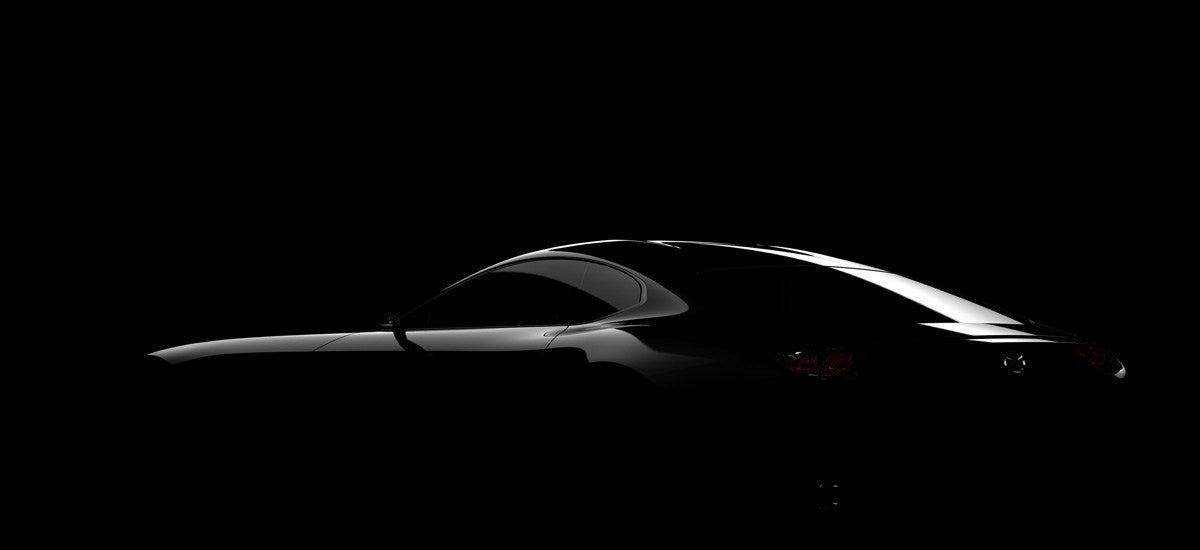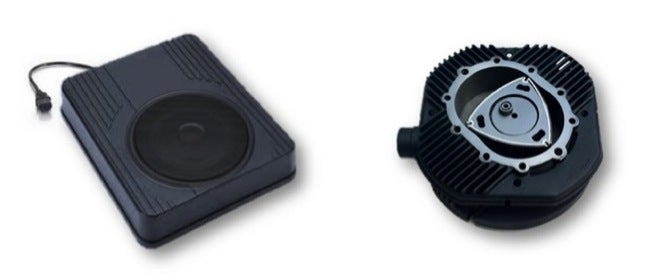 "SantaRita" (SantaRita)
"SantaRita" (SantaRita)
10/06/2015 at 16:37 ē Filed to: None
 2
2
 20
20
 "SantaRita" (SantaRita)
"SantaRita" (SantaRita)
10/06/2015 at 16:37 ē Filed to: None |  2 2
|  20 20 |
two seats, two doors, two pair of taillights, dual exhaust hatchback looking Mazda with a double bubble cabin.
please dear sirs, will you bless it twin rotors and twin turbo?

 Chariotoflove
> SantaRita
Chariotoflove
> SantaRita
10/06/2015 at 16:52 |
|
I know. Thereís nothing else out there. They just dropped this shadowy image and left the room. Itís killing me.
 Sir_Stig: and toxic masculinity ruins the party again.
> SantaRita
Sir_Stig: and toxic masculinity ruins the party again.
> SantaRita
10/06/2015 at 16:58 |
|
They posted on it, but there hasnít been more info so...
 SantaRita
> Chariotoflove
SantaRita
> Chariotoflove
10/06/2015 at 16:58 |
|
I really want the final release to be just like a total Ďdrop the micí too, lift the sheets, start it up and then just let it sit there idling like a pissed off weedeater for the rest of the day while all the mazda PR people jsut pack up go home, job done.
 Chariotoflove
> SantaRita
Chariotoflove
> SantaRita
10/06/2015 at 17:07 |
|
And wouldnít that be the most badass way to do it, too? No music, no Duran Duran, just a Mazda engineer getting out of the car and walking off stage while the world stares with their jaws on the floor.
 davesaddiction @ opposite-lock.com
> SantaRita
davesaddiction @ opposite-lock.com
> SantaRita
10/06/2015 at 17:15 |
|
Iím definitely excited about it. As is the Mazda m.o., it will be lightweight but somewhat underpowered compared to its competition, and have fantastic handling. Iím hoping it will also have a manual transmission (unless this is the reveal of their first dual-clutch box). Iím honestly doubtful about rotary power at this point, so MX-7?
When are we supposed to see the next Speed3?
 SantaRita
> davesaddiction @ opposite-lock.com
SantaRita
> davesaddiction @ opposite-lock.com
10/06/2015 at 17:30 |
|
I think they might make a case for rotary but it would have to be the larger size and much higher compression, like closer to 13:1 oftheir skyactive stuff. If weight really stay down around 2800lbs, they could build a case for it. The last rx8 was on the mx5 platform and if they used the same design rulebook fitting the motor would be just as easy as last time.
I would be still be very happy with an MX7or even mx-5 coupe, but to sell well it would have to have more power (like the 2.3T from Ford they donít have access to any more) and i donít see that happening with their current engines. Nor do i see them getting close to 200 sporty hp out of anything existing, even the 2.5L is only 187hp, and i donít see them undercuttin the FRS/BRZ in a halo car.
GTR is PR hit for Nissan, and phenomenal, Toyota has the next supra pending...NSX is closer than ever....
if there is a time to do anothe RX car, now is it. Mazda actually has the efficiency elsewhere in its range to justify one crazy ass model thatís greedier on fuel.
 davesaddiction @ opposite-lock.com
> SantaRita
davesaddiction @ opposite-lock.com
> SantaRita
10/06/2015 at 17:39 |
|
The next engine for the CX-9 is rumored to be a turbo 4 (based on the 2.5?) and will also be used in the next Speed3, and possibly in this (if theyíre willing to give up NA in their halo car). Eagerly awaiting...
 Sam
> SantaRita
Sam
> SantaRita
10/06/2015 at 18:26 |
|
I can tell you for certain that itís not going to be a traditional sports car. Itís going to be more near a GT car.
Itís being displayed alongside this -

Which isnít really much of a sports car. Itís more in line with a Thunderbird.
 spanfucker retire bitch
> SantaRita
spanfucker retire bitch
> SantaRita
10/06/2015 at 19:22 |
|
I really hope thereís no rotary engine. People have to give up and finally realize what a shit engine design the Wankel rotary is.
 MM54
> SantaRita
MM54
> SantaRita
10/06/2015 at 20:03 |
|
Hnnnnggggg itís beautiful
 davesaddiction @ opposite-lock.com
> Sam
davesaddiction @ opposite-lock.com
> Sam
10/06/2015 at 22:04 |
|
That would be a terrible mistake.
 SantaRita
> spanfucker retire bitch
SantaRita
> spanfucker retire bitch
10/07/2015 at 10:22 |
|
the wankel is ďjapanís engineĒand I wouldnt count it out. Itís an engine of compromises...and so are all engines... however very few of them have the rev ceiling and extra power strokes. Also itís modular, which is fairly unique. yes thermally, not efficient, but thatís the idle price of the extra power stroke even when you donít need it.
i still think mild hybrid rotary would be a balanced marriage. give you the torque down low and the smooth rev ceiling...the Electric brings in some needed efficiency and the wankel uses the extra power strokes to charge a supercpacitor bank (smaller, lighter, charge/dischage faster than battery).
riddle me this: if wankel is such junk, why is there such a following, especially in aviation and performance circles...
maybe itís like sushi...not everyone has a taste for it, but its still sublime to those who do.
 SantaRita
> davesaddiction @ opposite-lock.com
SantaRita
> davesaddiction @ opposite-lock.com
10/07/2015 at 10:24 |
|
if they can give up on the doritos, surely they can adapt to snails
 spanfucker retire bitch
> SantaRita
spanfucker retire bitch
> SantaRita
10/07/2015 at 10:38 |
|
Why is there such a following? Because people are illogical. Just because thereís a fan base of something doesnít make it good.
A wankel engine is ineffcient and unreliable by its very design nature - two things that Mazda has been absolutely prioritizing of late with Skyactiv over just about everything else from a mechanical perspective. No one else is making or even developing rotary powered automotive vehicles for a good reason - and thatís because the flaws are too big to ignore.
Mazda would be stupid in the extreme to try the rotary engine again. Itís dead, let it stay dead.
 SantaRita
> spanfucker retire bitch
SantaRita
> spanfucker retire bitch
10/07/2015 at 11:27 |
|
First of all, wankels are proven reliable when maintained and properly tuned, just like any car, and Audi has tried them as recently as 2011 in EV support roles where they are actually MORE efficient than a typical ICE.
Secondly efficiency doesnít actually matter in a low volume halo sports car. GTR gets 15/22 mpg, Hellcat 13/22, Mustang GT 16/25....the GTR is 3900lbs...even the Subaru STI gets 17/23 mpg!
Mazda can get numbers like that in a ~2800lb car, they did it in 1992 already. with more advanced body and modern ECUs this doesnít seem to be an unreasonable target for 2017.
A cultural lesson about japan and flaws: Wabi-Sabi
https://en.wikipedia.org/wiki/Wabi-sabi
 SantaRita
> spanfucker retire bitch
SantaRita
> spanfucker retire bitch
10/07/2015 at 11:40 |
|
this is a lot like saying that NA is dead, or Manual trans is dead, and guess what, sex is safer with a condom...
turbo is more efficient and makes more power, autoboxes are faster and allow there to be more efficiency engineered into shift timing, etc
...however sometimes you have to give up a little bit in the numbers game to find the purest experience.
 BoxerFanatic, troublesome iconoclast.
> SantaRita
BoxerFanatic, troublesome iconoclast.
> SantaRita
10/14/2015 at 11:30 |
|
16X as a dual-mode series-parallel hybrid, (Iíd suggest natural-gas burning, as well, but that might be a step further than theyíd go.)
It could have tech like internally oil-fed rotor seals, ceramic coatings, stratified burn with direct fuel and supplemental air injection, sapphire aperture laser igniters without the cavity in the rotor housing for the spark plugs, which un-seal the rotor chambers, and increase emissions and lose compression... theoretically for thermal recovery, it could use turbine compounding to mix waste heat back into the system as kinetic energy.
Low-speed and warm-up, the engine is steady-state mid-RPMs as a generator, directly powering the rear mounted traction motors, and ground-speed is directly managed by those traction motors. Essentially an on-board rotary-power-plant electric car.
At higher sustained speeds, a clutch would engage, and the throttle control would change modes to manage RPMs of the rotary, and the rotary would directly power the rear axle at a fixed ratio similar to a current top gear ratio and final drive, and the electric motors would disengage, or switch to electrical generator mode to re-charge the small battery buffer. The electric traction motors could also serve as a supplemental instant torque boost at speed, somewhat like a nitrous shot, for passing.
The rotary would never slog at low-RPMs with low torque and low oil pressure, which did no favors to the Renesis in the RX8. Low end electrtic drive would provide that stop-and-go instant torque. The rotary would be a generator, and a flexible high-speed propulsion source, where electrics start to really suffer from heat and unsustainable high current demand.
Short range (perhaps up to a few miles) of all-electric propulsion, but that isnít the point. But it would also allow for mitigating and managing hot-restarts of the rotary engine, to avoid flooding, without the car being immobile during that condition.
It would need two or three electric motors/generators, one mounted to the rotary engine, in leu of the transmission. Perhaps mounted to the front, instead of the rear, if the engagement clutch still is attached at the rear, with a torque tube to the rear axle.
At the rear axle, it would be similar to the Tesla Model S rear axle, with one or two traction motors mounted near the center, on a subframe assembly, where the mass is sprung, not at the un-sprung end of the suspension. Two smaller motors, with a sophisticated pair of linked controllers could implement torque vectoring to the point that a limited slip differential would be a moot point.
The rear drive assembly would also need a small planetary gear set to mix in the kinetic drive input from the rotary when engaged at high speeds. It would need to switch or mix the inputs, but would not necessarily need multiple drive ratios like a traditional transmission, if the electric motors have their ideal high torque drive ratio, and the rotary has itís high-speed ratio.
Theoretically, two additional small motors/generators on the inboard side of the front suspension (sprung weight again) could add more regenerative braking energy recovery, and front-assist slip-responsive fully-independent All Wheel Drive. I have always wondered if regenerative braking generators could somehow be integrated with inboard friction brakes, as well, to really keep unsprung weight and wasted heat/kinetic energy to a minimum.
 SantaRita
> BoxerFanatic, troublesome iconoclast.
SantaRita
> BoxerFanatic, troublesome iconoclast.
10/15/2015 at 10:05 |
|
Thank god, someone else with some imagination.
some things i would consider...instead of a small battery buffer, use a set of super-capacitors so they can be cycle power in and out even faster. I think taking a ferrari FF approach would be worth considering. Package a drive/regen motor at each front corner, but use them exactly as you describe...for low rpm, warmup, all of the subtle/fragile areas owners had a choice to neglect previously would be taken away.
i always see this motor combo as packaged as a set of pancakes: [rotor, rotor, EV/trans] pancake like in the 5speed Honda insight.
 BoxerFanatic, troublesome iconoclast.
> SantaRita
BoxerFanatic, troublesome iconoclast.
> SantaRita
10/15/2015 at 11:50 |
|
For a while, I was actually considering a pure series hybrid, with no kinetic drive engagement...
Clarian Labs was working on a wankel rotary generator, with the generator integrated into the rotor and eccentric shaft.

Fuel and air in, perhaps a bit of electricity input to start, with exhaust and more electricity out.
And with the size, they could be stacked, modular and scalable. 3 or 4 of them in an assembly, but not kinetically linked, would be a nice scalable generator. One running when required to supply baseline current, with more of them kicking in based on electrical demand if the battery or capacitance buffer is being depleted faster. It could also track runtime on each rotor-generator assembly, and shuffle usage to manage both heat soak and rotor seal wear over time.
However, I still like the idea of a rotary engine with multiple rotors on a common kinetic-output eccentric shaft, that can be engaged to directly drive the vehicle at higher speeds, where the conversion from [Chemical stored energy(fuel)->thermal energy(combustion)->kinetic energy(engine)->electric energy(generator)->kinetic energy(traction motor to wheels to ground)] gets a bit lossy, and strenuous at high heat and high current demand for an electric motor to drive the wheels at high ground speeds. Removing the last two energy conversions, and going straight from engine output to wheels to ground is less parasitic loss, and more direct transfer. I am not a huge fan of Chevy Volt or GM in general, but at least they are somewhat right about their hybrid implementation, generally, for low-speed generation, and high-speed direct engagement.
 SantaRita
> BoxerFanatic, troublesome iconoclast.
SantaRita
> BoxerFanatic, troublesome iconoclast.
10/15/2015 at 13:01 |
|
Eventually, I see the electric motor as rotary and you can delete the wankel and end up with the same characteristics.
Mazda doesnít have the historical background to support a new Ďtesla roadsterí that thank god, but building a poor mans bmw i8 or an enthusiast EV might also hit at exciting weight targets. ( guarantee weight is low to the ground though)
My thinking on the pancake rotors with an EV-supported rotor and the control electronics required, timing and even rotor speed could be sent/controlled in a much finer manner, helping efficiency along.